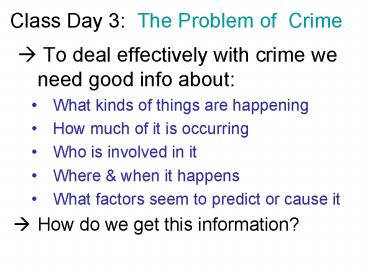Class Day 3: The Problem of Crime - PowerPoint PPT Presentation
1 / 24
Title:
Class Day 3: The Problem of Crime
Description:
Official records (of criminal justice events from CJ agencies who handle cases) ... Part 2 involves both violent & property crimes, as well as vice/disorder crimes ... – PowerPoint PPT presentation
Number of Views:81
Avg rating:3.0/5.0
Title: Class Day 3: The Problem of Crime
1
Class Day 3 The Problem of Crime
- ? To deal effectively with crime we need good
info about - What kinds of things are happening
- How much of it is occurring
- Who is involved in it
- Where when it happens
- What factors seem to predict or cause it
- How do we get this information?
2
? How to get empirical crime data? Different
info sources on social events
- Official records (of criminal cases)
- Surveys (of peoples experiences)
- Observations (of criminal events)
- Other sources (of information about criminal
persons or events)
3
? Sources of crime data
- Official records (of criminal justice events from
CJ agencies who handle cases) - Police ? the Uniform Crime Reports
- Police records of crimes known and arrests
- the paper trail left by cases handled by police
- Crime summaries are forwarded to, collected by,
published by the FBI (through state police) - Traditional Division into 2 categories
- Part I the Index Crimes (Crimes known
Arrests) - Part II all other crimes (arrests only)
- Traditionally the data most commonly used
- Problem of selective reporting dark figure
- Aggregate reports collective summaries
4
? Sources of crime data
- Official records (of criminal justice events from
CJ agencies who handle cases) - Police ? the Uniform Crime Reports
- Courts (cases filed adjudications)
- Juvenile courts
- Administrative/regulatory courts
5
? Sources of crime data
- Official records (of criminal justice events from
CJ agencies who handle cases) - Police ? the Uniform Crime Reports
- Courts (cases filed adjudications)
- Corrections ? data on recidivism (relapse)
- These only reflect the cases processed by the CJS
- Also Semi-official records (schools, ERs,
DFSC, insurance companies)
6
? Sources of crime data
- Surveys (of potential victims offenders)
- What do surveys involve?
- Sample from population
- Questionnaire or interview
- Kinds of surveys used
- Victimization Surveys
- Self-Report Surveys
7
? Sources of crime data
- Surveys (of potential victims offenders)
- Victimization surveys
- Survey of population re victimization
- Official victim survey NCVS (BJS)
- Unofficial surveys (for special crimes)
- Self-report surveys
- Juvenile delinquency
- Ordinary crimes
- Vice crimes (e.g., drugs, deviance)
8
? Sources of crime data
- Surveys (of potential victims offenders)
- Strengths weaknesses of surveys?
- More detailed info on events and persons
- Include unreported/undetected crimes
- Biases errors?
- Comparison of surveys with official record data?
- Which kinds of data are best for which kinds of
crimes?
9
? Sources of crime data
- Observations
- Natural events (field studies)
- Controlled events (experiments)
- Other possible sources
- Life Histories
- Clinical Case materials
- Historical documents
- Media accounts
10
? What kinds of crimes occur?
- Part I crimes?
- Part II crimes?
- Other crimes?
- White-collar crimes
- Organized Crime
- International crimes
11
Part I (Index) Crimes
- About 12 are violent (crimes known)
- About 88 are property crimes
- Crimes known vs. arrests?
- Which ones are most reliable?
- 47 of violent crimes reported to police
- 40 of property crimes reported to police
- 46 of reported violent crime result in arrest
- 17 of reported property crimes result in arrest
12
Clearance/Arrest Rates (UCR)
13
Part II Crimes (all other crimes)
- Only arrest statistics reported
- 84 of all arrests involve Part II crimes (16
Part I arrests) - Largest category vice or public order crimes
(alcohol drug-related) - Part 2 involves both violent property crimes,
as well as vice/disorder crimes - Cover the whole range of severity (from trivial
deviance to fatal violence)
14
Is the problem of crime changing?
- Regular cycles?
- time of day seasonal variations
- Non-cyclical trends and changes?
- Over the centuries?
- During last century?
- Since 1990?
- Since 2000?
- Short-term fluctuations noise
- Future trends?
15
Serious Crime Rates (UCR)
16
U.S. Murder Rates (UCR)
17
Violent Crimes (UCR NCVS)
18
Property Crime (from NCVS)
19
Where do crime occur most?
- International patterns?
- Regional differences?
- Urban-rural differences?
- Public spaces
- Residential locations
20
Who commit crimes (usually)?
- Age
- Gender
- Social Class
- Race
21
Age Patterns
- The Universal Age Curve of crime
22
Gender Patterns
- Different percentages/ratios of male-to-female
involvement in crime - Violence about 8-to-1
- Property about 3-to-1
- Historical explanations for gender differences?
- Recent changes in female criminality?
- Liberation effects (equality in all things)?
- Convergence hypothesis?
- Note differences between property violence
- Problem of relying on arrest data?
23
Racial Patterns
- Large, persistent differences in arrest rates
- Other offenses may show different pattern
- Violent crimes (including domestic violence)
- Property Crimes
- Substance Abuse
- White-Collar crimes
- Organized crimes
- Other crime data sources may be different
- UCR vs. NCVS vs. Self-report
- ? The racial picture is more complex if we look
at all the data (not just the UCR arrests)
24
Characteristics of Victims?
- Similar profiles to Offenders
- Young
- Male
- Minority
- Poor

